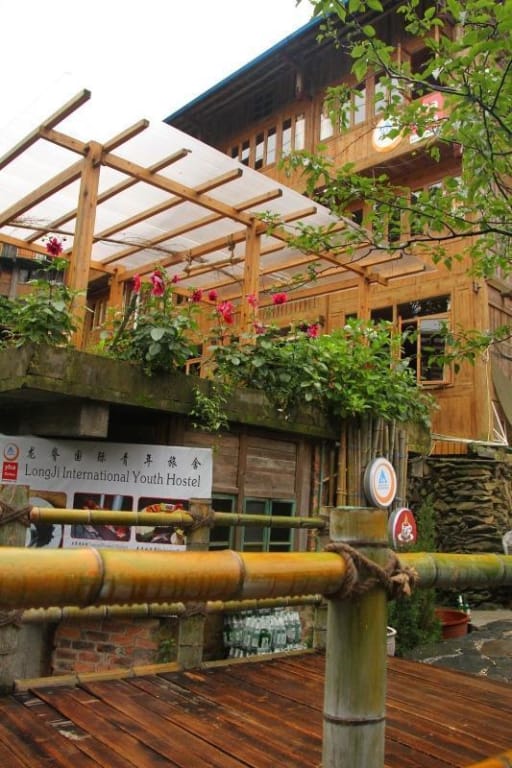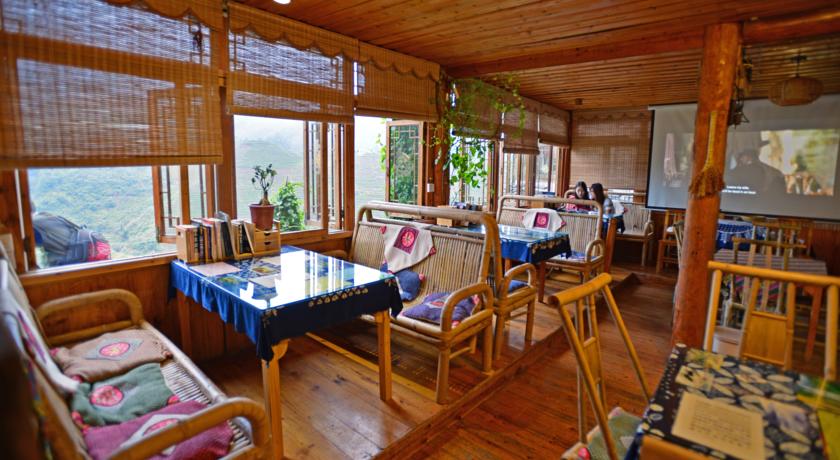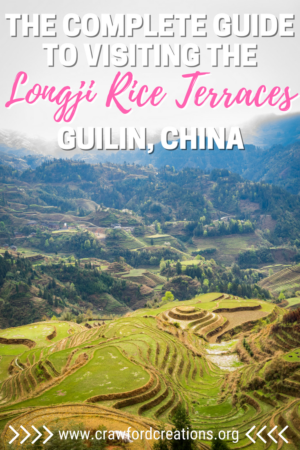The Complete Guide To Visiting The Longji Rice Terraces, Guilin
***This post may contain affiliate links.***
The Longji Rice Terraces are Guilin’s very much underappreciated gems. Overshadowed by the famous Li River and surrounding karst scenery, the Longji Rice Terraces (also called the Longsheng Rice Terraces) are often viewed as a bit of an afterthought on the Guilin travel radar. Something to see only if you have the time.
In a way, I appreciate this mindset because it keeps the rice terraces pristine, and a bit undiscovered. But, on the other hand, it also makes me want to shake these people so hard and just scream “What are you doing?! You have to go to the Longji Rice Terraces! They’re incredible!!!” Because, well, they are!
Why Travel To The Longji Rice Terraces?
I can’t say that the Longji Rice Terraces are better than the Li River scenery around Guilin and Yangshuo, but it is for sure on par in epicness. At the Longji Rice Terraces, you can stay in a wooden house built on the side of a mountain with a 180-degree view of nothing but cascading rice terraces and a backdrop of huge mountains. Plus, you have access to a maze of hiking trails through the rice terraces full of incredible overlooks and views with hardly anyone else on them. Does that not sound dreamy?!
And honestly, you don’t even have to be into hiking to enjoy the Longji Rice Terraces. You can take a cable car up to one of the highest viewpoints and bask in amazement at the incredible scenery without setting one foot on a set of stairs. You won’t get to see as much, but, ya know, it’s doable, and would still be totally worth the trip.
Whether you’re an avid hiker or just someone who appreciates beautiful scenery, the Longji Rice Terraces are an absolute must see. Oh, and if you’re into unique culture and history too, forget about it, you’ll be in heaven up here.
The Longji Rice Terraces are home to two different Chinese ethnic minorities, the Zhuang and the Yao people. These people have been cultivating rice in the Longsheng mountains for centuries. They live completely off the land and, fun fact, the women here have some of the longest hair in the world! It’s tradition that girls cut their hair only once in their life when they turn 18. Most of the local women you’ll meet at the rice terraces have hair that’s over 1 meter long!
Read More From Guilin
- Follow Us To Guilin: The Ulitmate 1 Week Guilin Itinerary
- The Best Views In Guilin, China: 5 Jaw-Dropping Mountaintop Views And How To Find Them
- The Best Way To Experience Guilin: Bamboo Rafting Down The Li River
Longji Rice Terraces

The Longji Rice Terraces, also called the Longsheng Rice Terraces or Dragon’s Back Rice Terraces in English, were created hundreds of years ago. Construction of the rice terraces spaned the Yuan and Qing Dynasties lasting for over 600 years from 1271 – 1911.
Today, the completed fields cover an area of 66 square kilometers (25 square miles) and are split up into two sections, the Ping’an Rice Terraces and the Dazhai Rice Terraces (also called the Jinkeng Rice Terraces).
Where Are The Longji Rice Terraces?
The Longji Rice Terraces are located 95 kilometers north of Guilin City in Longsheng County.
The Best Time To Visit The Longji Rice Terraces

May/June
The best time to visit the Longji Rice Terraces is during the months of May and June. This is the time just after the farmers have planted their new crops of rice and the fields are full of water making for beautiful reflections, especially at sunrise and sunset.
The weather is also nice during this time, with some rain, but no thunderstorms, and pleasant temperatures that are not too hot during the day and not too cold at night. By the end of June, the summer monsoon season kicks in and the weather gets rather dicey, with hot temperatures and lots of thunderstorms.
September through mid-October are also good months to visit, but with drastically different scenery. During the early fall months, the rice is ready for harvest and the grains have all turned a golden yellow. The weather during this time is ideal for traveling as it’s dry and sunny with pleasant temperatures that are not too hot during the day and not too cold at night. Don’t come too late in October though or you’ll miss the rice altogether and will be left with nothing but brown dirt terraces after the harvest.
Ping’an vs. Jinkeng (Dazhai) Rice Terraces
The Longji Rice Terraces are split into two sections, Ping’an Zhuang Village Terraced Fields and Jinkeng Red Yao Terraced Fields. Each village is home to its own minority group. Ping’an is home to the Zhuang people while Jinkeng is home to the Yao people.
The main difference between the two areas is that Ping’an is one large village that’s been pretty well developed for tourism, while Jinkeng is made up of many small villages dotted along the mountainside and is less commercialized.
Ping’an Rice Terraces

Ping’an is the older and more developed of the two sections of rice terraces. It’s also the first section of rice terraces you come to when entering the Longji Terraced Fields Scenic Area.
While Ping’an is more developed than Dazhai, it’s also less scenic. There are simply fewer rice terraces in Ping’an than in the Jinkeng area. This is probably due to the fact that with multiple villages spread around the valley, the Yao people can more easily farm a larger area than the Zhuang people who all live in one spot on the mountainside.
Don’t get me wrong, the Ping’an Rice Terraces are absolutely beautiful. It’s just that they’re confined to one side of the valley, whereas at Jinkeng, the entire valley is covered in rice terraces. This also means that there are not many hiking trails around the Ping’an Rice Terraces. You can hike up to the two viewpoints and that’s about it unless you want to do a long hike all the way over to Tiantou Village in the Dazhai Rice Terraces.
While Ping’an is more commercialized than Dazhai, take that with a grain of salt, because it’s still pretty damn authentic. The entire village is still built out of stilted wood houses, and the people still dress traditionally and farm the land by hand, it’s just that now instead of simply residential houses and a couple hotels, there are numerous hotel options, many different restaurants, and even a couple bars.

The people of Ping’an village are incredibly nice, some of whom even speak English, which really surprised us. Amidst the village’s development, you can still find lots of authentic and very personal experiences. We met a super friendly woman after hiking one afternoon who invited us into her guesthouse and offered to cook us a local meal for lunch.
She cooked us up a giant pot of chicken and snail soup as well as a dish of deep-fried glutinous rice covered in sugar. After serving us our food she took the time to teach us how to eat the little snails and told us how they catch them from the rice terraces. As the lone English speaker we encountered, she very patiently fielded all of our questions about life in the Longji Rice Terraces.
We left Ping’an with the feeling that tourism has actually been good for the people in these villages. Tourists have given the local people the opportunity to have other income streams outside of farming rice by opening up guest houses and restaurants, which most families in the village have. Life on the mountainside is tough, and the locals here are grateful for the additional business.
Dazhai Rice Terraces

The technical name for these rice terraces is the Jinkeng Rice Terraces, but honestly, nobody in Guilin calls them that. They are known colloquially as the Dazhai Rice Terraces after the largest village in the Jinkeng section, Dazhai. Dazhai village is the first village you come to at the Jinkeng Rice Terraces, located just past the entrance.
The Dazhai Rice Terraces are newer to tourism, and therefore less commercialized. There are much fewer places to stay or eat here, but the scenery is far more impressive.
I say Dazhai is less commercialized, but there is a cable car that runs up to the top of the mountain, so they are most definitely trying to entice tourists to come. The addition of the cable car has certainly attracted a lot more day tourists to this section of rice terraces, but if you choose to stay the night, you’ll have the place almost entirely to yourself.
The Dazhai Rice Terraces are famous for their incredible viewpoints. Here, the terraced fields encircle the entire valley giving you an incredible panoramic view. The best way to appreciate the stunning scenery is to hike from Golden Buddha Peak, near where the cable car ends, to Tiantou Village.
The Jinkeng area is made up of several small villages, including Dazhai, Tiantou, and Xinzhai plus a few others that are literally too small to make it onto the map. Each of the villages is connected via numerous walking paths, making for a virtually endless maze of hiking opportunities.
We never got the opportunity to talk to the locals here like we did in Ping’an as we didn’t stay in any of the main villages and the locals who ran our hotel mostly just kept to themselves. Instead of immersing ourselves in the culture like we did in Ping’an we looked at Dazhai more as an opportunity to do lots of epic hikes and see incredible views. Which we definitely accomplished.
Ping’an or Dazhai, Which Is Better?
Dazhai

Overall, I would choose Dazhai over Ping’an mostly because there are so many more hiking opportunities with better views. Ping’an for us was more of a cultural experience, whereas Dazhai was more about the hiking and surrounding scenery. Not that we don’t care about culture, we do, but considering we came to the rice terraces for the scenery, Dazhai definitely wins on that front.
That being said, if you’re an avid hiker, the ultimate trip would definitely be to arrive at the Ping’an Rice Terraces, hike up to the viewpoints, grab lunch, and then hike all the way to Tiantou Village at the Dazhai Rice Terraces. Stay the night in Tiantou Village, and then hike up to the Tiantou Village viewpoints the next day before heading down the mountain and leaving from Dazhai Village.
It’s a lot of hiking, but you would get to experience both sections of rice terraces and see all the best views in one trip!
How Long Should You Spend At The Longji Rice Terraces?
2 Days
The ideal amount of time to spend at the rice terraces is 2 days. This is due to both the fact that your entrance ticket is good for 2 days, and also the fact that it takes 2-2.5 hours to get to the rice terraces from Guilin. In addition, the last buses leave the rice terraces to return to the Guilin at 4:00 pm.
You simply won’t have enough time to see much of the rice terraces on a day trip as even if you took the first bus out of Guilin at 8:30 am, it will be 11:00 by the time you get to the rice terraces. Then factor in 30 minutes to 1 hour for hiking up the mountain to Ping’an or Tiantou Village, eating lunch, and you’re left with enough time to see one or two viewpoints before it’s time to hike back down the mountain and catch the bus back to Guilin.
How to Get To The Longji Rice Terraces From Guilin

From Guilin, take the 8:30 am long-distance bus from the Guilin Train Station or the tourist bus which leaves from the neighboring Jinyi Holiday Hotel parking lot. You can book direct bus tickets from Guilin to either Ping’an or Dazhai Village via the receptionist at your hotel. Virtually all hotels and hostels in Guilin offer this service for no extra fee. You simply pay the receptionist and he or she will give you a receipt that acts as your bus ticket.
The bus ride from Guilin to Ping’an Village takes 2 hours, while the ride from Guilin to Dazhai Village takes 2.5 hours.
Guilin to Longji Rice Terraces Bus Ticket Price
50 RMB per person.
Longji Terraced Fields Scenic Area

All the buses that run to the Longji Rice Terraces will stop first at the entrance to the Longji Terraced Fields Scenic Area. In order to get to the rice terraces, you must first pay an entrance fee to get into the scenic area. If you’re taking a direct tourist bus to Ping’an or Dazhai village do not get off the bus when it stops at the scenic area entrance. Someone will come on the bus to sell tickets to all the passengers.
Longji Terraced Fields Scenic Area Entrance Fee
95 RMB per person
Your entrance ticket to the Longji Rice Terraces is good for 2 days.
Hiking The Longji Rice Terraces

The best thing to do at the Longji Rice Terraces is go hiking. The easiest and most well-marked hikes at the Longji Rice Terraces are to all of the viewpoints as well as a long trail that connects the Ping’an and Dazhai Rice Terraces.
Best Hikes At The Ping’an Rice Terraces

1. 7 Stars Around The Moon Viewpoint
2. Nine Dragons and Five Tigers Viewpoint
3. Longji Ancient Zhuang Village Hike (2.5 kilometers)
4. Ping’an to Tiantou Village Hike (9 kilometers)
All of these hikes are pretty well marked. Simply follow the signs from Ping’an Village to each of these places.
Best Hikes At The Dazhai Rice Terraces

1. Golden Buddha Peak
2. West Hill Music Viewpoint
3. Sky Ladder Viewpoint
4. Qiangbei to Tiantou Village Hike (5 kilometers)
5. Tiantou to Ping’an Village Hike (9 kilometers)
The Qiangbei to Tiantou Village hike is the only one that’s not marked by signs. This hike starts just up the hill from the upper cable car station, but it’s a bit tricky to find the entrance.
There is a marked trail from the cable car station to Tiantou Village but it’s much harder and less scenic than the long route. Following the signs for Tiantou Village will take you almost all the way down the mountain and back up again on lots of stone steps.
Tiantou Village is on the other side of the valley from Qiangbei and the cable car station, but there is a dirt trail that runs ridgeline the long way around to Tiantou Village. While this hike is longer, it’s way easier as it is virtually flat, and way more scenic as the trail stays up on top of the mountain.
The easiest way to find the scenic trail from Qiangbei to Tiantou is to use Maps.me. You’ll see a clearly marked trail on the map that is the only trail that runs around the top of the mountain between these two villages. This is the trail you’re looking for. Once you’re on the trail it’s a straight shot between the two villages.
Of course, you can start this hike from Tiantou Village as well. We just ended up staying at a guesthouse near Golden Buddha Peak in Qiangbei Village so we started the hike from there.
If you’re hiking from Tiantou Village, don’t follow the signs for the cable car station or Golden Buddha Peak as they will take you up and down the stone steps. Instead, stay on top of the mountain and walk towards the Longji Panorama House Hotel just up the hill. Once you reach the hotel, continue up the hill to the right along the stone path.
Continue following this path along the side of the ridge to Qiangbei Village. If you’re unsure of where you’re going you can always check Maps.me to make sure you’re on the right path. The trail between the two villages is marked on the map.
Best Places To Stay At The Longji Rice Terraces
Ping’an
Ping’an Travelling With Hostel

Located near the 9 Dragons and Five Tigers viewpoint, Ping’an Travelling With Hostel is built in the traditional Zhuang style, but with a modern twist. The hostel is modern, clean, has amazing private rooms, excellent views, free wifi, and friendly English speaking staff. They also have an onsite restaurant serving up delicious local cuisine.
Click here to check the latest prices and availability at Ping’an Travelling With Hostel.
Longji International Youth Hostel

Longji International Youth Hostel is located in the heart of Ping’an Village, exactly halfway in between the 7 Stars Around the Moon and the 9 Dragons and 5 Tigers viewpoints. The hostel is built in the traditional Zhuang style with simple wooden rooms, a cozy outdoor terrace, good views, free wifi, friendly English speaking staff, and a nice cafe on site that serves western breakfast.
Click here to check the latest prices and availability at Longji International Youth Hostel.
Longsheng Longji Holiday Hotel

Set up on the hill near the top of Ping’an, the Longsheng Longji Holiday Hotel boasts incredible views of Ping’an and the surrounding rice terraces. The hotel is beautiful, clean, has big rooms, great views, free wifi, friendly English speaking staff, and an onsite restaurant.
Click here to check the latest prices and availability at the Longsheng Longji Holiday Hotel.
Dazhai
Tian Ranju Inn

Located in Tiantou Village at the top of the Dazhai Rice Terraces, Tian Ranju Inn is a beautiful traditional styled hotel with incredible views of the surrounding rice terraces. The hotel rooms are simple but still nice, clean, comfortable, and have amazing views. Tian Ranju Inn offers free wifi, an onsite restaurant serving up delicious food, and great English speaking staff.
Click here to check the latest prices and availability at Tian Ranju Inn.
Dazhai Dragon’s Den Hostel

Dazhai Dragon’s Den Hostel is located in Tiantou Village in a traditional wooden stilted house. The hostel is beautifully decorated with a very cozy feel. The rooms are comfy, the hostel has incredible views of the surrounding rice terraces, free wifi, super friendly English speaking staff, and an onsite restaurant that serves both great local and western cuisine, including real coffee in the mornings.
Click here to check the latest prices and availability at Dazhai Dragon’s Den Hostel.
Salad Days Hostel

As the newest hostel in Tiantou Village, Salad Days Hostel is incredibly nice, modern, and super clean. The hostel has a nice outdoor terrace to enjoy the beautiful view of the rice terraces, amazing rooms with a view, free wifi, friendly English speaking staff, and an onsite restaurant that serves great local and western food. Salad Days Hostel is also ideally located for those looking to make the long hike from Dazhai to Ping’an Village.
Click here to check the latest prices and availability at Salad Days Hostel.
Read More From Guilin
- Follow Us To Guilin: The Ulitmate 1 Week Guilin Itinerary
- The Best Views In Guilin, China: 5 Jaw-Dropping Mountaintop Views And How To Find Them
- The Best Way To Experience Guilin: Bamboo Rafting Down The Li River
WANT TO TRAVEL CHEAPER & EASIER?
Subscribe to follow our blog and be the first to read our new posts!
Success! Happy dance optional :) P.S. check your inbox for goodies!
Like this post? Share the love and pin it on Pinterest!

*** This post may contain affiliate links. By purchasing a product or service through these links you are helping to support this blog at no extra cost to you! We only recommend products we personally use and love! ***





 Hey, we're Cara and Justin, the adventure travel loving couple behind Crawford Creations. We're here to help you travel the world independently, save money on your travels, and discover off the beaten path destinations along the way. Click the About tab to find out more!
Hey, we're Cara and Justin, the adventure travel loving couple behind Crawford Creations. We're here to help you travel the world independently, save money on your travels, and discover off the beaten path destinations along the way. Click the About tab to find out more!



i didn’t know rice terraces can be that beautiful. The photos are truly amazing!
Hey, thanks for the detailed blog about the logistics for visiting Longji rice terraces. If you’ve got a second can you help me out with two quick questions:
1) When you say the ticket is valid for 2 days does that mean you literally need to arrive on one day, and leave the next day (so just accommodation for 1 night)? I was thinking of staying for 2 nights – so I’d need two tickets?
2) I can only arrive in early Nov – I know I’ll have missed the best version of the terraces, but is it still beautiful to visit later in the year?
Thanks!
Hey Blake,
Technically your ticket is valid for 2 full days from the date of purchase, meaning if you purchase your ticket at 11am on Monday, for example, it is good until 11am on Wednesday, so you can definitely stay for 2 nights with just 1 ticket. Honestly though, nobody checks your ticket as you leave, only when you enter, so really you could stay as long as you want! As for timing, the farmers harvest the rice during the first 2 weeks of October, so going in November all the terraces will be empty and brown. I think it would still be cool though, especially if you’ve never been before. Plus you’ll probably have the place virtually all to yourself as not too many people visit this time of year. If you search “longji rice terraces guilin november” in Google Images there a few photos of the terraces after harvest that will give you a good idea of what to expect and if you think it’s worth going. Hope this helps! Have a great trip 🙂
Cara
Hi Cara,
Thanks for the wonderful post with so many details.
I have a small inquiry and I hope you can spare 1 min for me.
I just want to know whether it’s better to stay at Dazai or Pingan and whether there is a place to store the luggages since I would love to be able to stay at Tiantou for the view, but the idea of hiking with the luggages are not so appealing. Unfortunately we also cannot leave the luggage at Guilin as we will head to Yansuo directly, after the terrace.
Thanks!!
I would recommend staying at Dazhai over Ping’an personally as there were less tourists, although honestly, if it’s your first time to the terraces you will love either one. They are both gorgeous! As for your luggage, Dazhai has a cable car you can take up the mountain with your luggage, and there are multiple hotels right where the cable car drops you off that you can stay at. If you choose Ping’an there are tons of locals waiting with baskets to carry your luggage up the mountain for you for a small fee. And I agree, it would be no fun to carry your stuff all the way up those stairs :). Have a great trip!